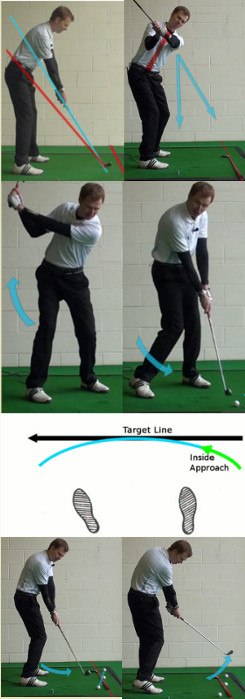You're Correct!

As bad as slicing is, there are at least two maladies that make it seem benign by comparison: shanking, and hooking. Both can be caused by a swing thats too “flat.”
In this context, “flat” describes a swing plane in which the golfers left (lead) arm, at the top of the backswing, is at less than a 45° angle relative to the ground. Matt Kuchars swing offers a great illustration.
In fact, a flat swing plane does have its advantages. For starters, it can help cure a slice.
Because the arms and club move more around the body, a flat swing promotes an inside-to-outside clubhead path – the opposite of the outside-in or over-the-top move which plagues many slicers. Swinging inside-out enables you to hit a draw and transfer more power to the ball, two highly desirable traits.
Now for the downside. If your swing becomes too flat, the clubs path will be too far from inside the target line. If you fail to fully release the club from this position, its easy to shank the ball off the hosel of an iron or catch it deep in the heel of a wood or hybrid. Rotate the hands a little too much and youll hit some huge hooks.
In other words, a flatter swing can cure you… but it may kill you.
If youre sure that an overly upright swing is causing you to slice, by all means try flattening it out. Heres a handful of tips:
Move away from the ball: On the practice tee, grab the shortest club that you tend to slice. Assume your normal stance, and shuffle your feet (and body) just slightly away from the ball – no more than an inch to begin with. You may feel like youre reaching for the ball, but thats OK. The extra distance will make you swing around your body and limit your tendency to come over the top. Adjust your stance distance based on the results. Remember, farther means flatter
Tee it higher: Raising the level of the ball lowers (flattens) the level on which your shoulders and arms rotate. If you tee the ball too low, youll also stand closer and force yourself into a more upright position.
Practice with the ball above your feet: This has the same effect as teeing it higher. By practicing this way, youll develop a feel for a flatter swing.
Make a baseball-style practice swing: Another simple trick to ingrain the feeling of a flat plane. Just hold the club straight out from your body as though holding a bat over the plate. Swing back and through, back and through, rotating the forearms and hands through the impact zone. Thats the sensation you want when hitting the golf ball.
A flatter swing can, indeed, be the answer to your slice. The key is to not go too far.
Slicing is the single most common problem among amateur golfers. If youre a victim, one of these links may well lead to the fix youve been looking for:
Sorry Try Again! - See Explanation Below
Its highly unlikely that flattening your swing will exacerbate a slice. By shallowing your swing plane, youll find it easier to route the club on an inside-to-out path. (Most slicers swing outside-in.) The problem is, you could develop a case of the shanks or hooks if your swing gets too flat.
Sorry Try Again! - See Explanation Below
Believe it or not, swinging inside-to-out doesnt necessarily eliminate slicing. If you fail to release the club through impact, your pull slice may simply become a push slice – arguably, an even worse ailment.
Sorry Try Again! - See Explanation Below
If this were true, there would be a lot fewer golfers in the world. In fact, there are multiple prescriptions for all slice types and causes. A flatter swing is recommended for golfers with extreme over-the-top club paths. Others must squash a reverse pivot, or change their grip, or… You get the picture.







